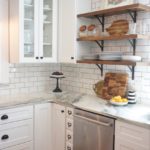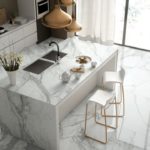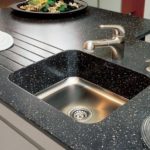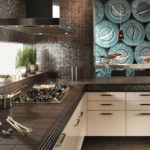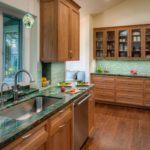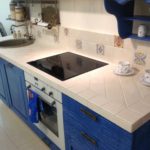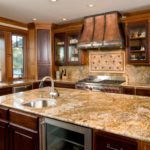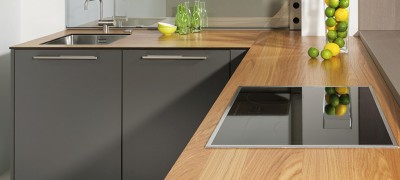Standard sizes for kitchen countertops
The countertop is an indispensable attribute of the kitchen, near which housewives spend most of their time. Most of the actions associated with cooking are performed using this particular element of the kitchen interior. Therefore, when choosing a countertop, in addition to aesthetic, practical parameters of its operation are no less important.

The dimensions of the table for processing products in accordance with GOST were derived based on the dimensions of the kitchen of a typical apartment, and have the following meanings:
- The length of the worktop for the standard kitchen is 100 cm.
- The width of the worktop for the standard kitchen is 60 cm.
- The thickness of the worktop for the kitchen is standard - 3 cm.
- The standard depth of the kitchen countertop is 90 cm from the floor.

The latter figure was derived from the average height of a woman, which is 160 cm.This standardized approach led to the fact that taller women were forced to constantly bend over to the working surface of the countertop, and smaller ones - to stand on their toes or lay out a platform made of boards on the floor.

A modern hostess has the opportunity to purchase and install a countertop with any parameters convenient for her. Moreover, in addition to the individual sizes of the countertops, there is a huge assortment of products made from various materials on the kitchen furniture market. Moreover, each product has both its advantages and disadvantages.

When choosing a countertop for a kitchen, you need to understand what kind of workload its surface will experience on a daily basis.
Stone
The craftsmen lay out the covering made of natural stone in the form of a perfectly flat surface. The color of the stone can be matched to the general interior style, or vice versa - to highlight the working area due to contrast. Of the advantages of a stone countertop, the following useful features can be distinguished:
- Stone is an inert material. Does not absorb odors and chemicals.
- Environmental friendliness. Does not release toxins and does not change properties under the influence of temperature.
- Strength. The stone is resistant to mechanical damage to the surface.
- Such material is not picky about care. The stone countertop can be cleaned even with caustic substances.
- External aesthetics. The surface of technologically processed natural stone adds a certain solidity to any interior style.

The golden hands of masters in combination with numerous design ideas are able to satisfy even the most sophisticated taste of modern housewives, decorating their kitchen space with their products.
Acrylic
The acrylic surface of the countertop is 1 to 2 cm thick and is usually installed on a footboard made of a different material. Acrylic is an artificially created material and has a number of the following advantages:
- Water repellent property. Liquid stains do not bite into the acrylic surface and can be easily removed even after a long time. Acrylic owes this quality to its structure with low porosity.
- Strength.Resistant to scratches and mechanical stress. Easy to recover.
- Does not absorb odors.
- Huge color gamut. The synthetic nature of the material allows you to give it any color.

However, when choosing this polymer material, do not forget that it is subject to destruction by acetone and other caustic substances that are often present in powerful cleaning agents. Also, a serious drawback of acrylic countertops is its temperature response. Hot kettle and boiling water leave dark marks on the acrylic surface.

MDF and chipboard
Chipboard (chipboard) has only one significant advantage over other materials of furniture sets - a low price. For the rest of the indicators for the tabletop, chipboard is an unconditional outsider.

A chipboard tabletop for relative durability should have a thickness of at least 5 cm. Due to its low cost, it is often used as a footboard for another, more expensive material. This significantly reduces the cost of the furniture product in the store.
Unlike chipboard, MDF (Medium Density Fiberboard) sheet is an improved type of pressed shavings with slightly better performance. At the same time, poor fire resistance makes MDF not the best material for a countertop adjacent to a slab.
Wood
Wood is considered a traditional material for any piece of furniture set. Prices for products depend on the type of wood. The most expensive wooden countertops are made from beech and oak. Cheaper options are made from softwood or birch.

To increase moisture resistance and fire resistance, the wood is impregnated with special substances and a protective layer of varnish is applied to the wooden surface. One of the main advantages of a wooden countertop is, of course, its environmental friendliness. The disadvantage is the exactingness of care, susceptibility to mechanical damage and sensitivity to sudden changes in temperature.

Quartz agglomerate
The quartz countertop is recognized as the leader in resistance to mechanical stress. It is difficult to leave a scratch or deformation on it from a direct impact. All other necessary indicators for the table top are also in the leading positions. The quartz surface is unpretentious in maintenance, moisture resistant, indifferent to temperatures and visually attractive.

Quartz countertops have only two drawbacks - an expensive price and a three-meter size limit. The latter circumstance is due to the supply from Turkey and India of plates, cut at the plant by three running meters. At the same time, their connection for headsets with countertops more than three meters has an unaesthetic joint.

Marble and Granite
From time immemorial, these two materials, similar in quality, have been used for the construction of durable elements of any structure. Marble columns and granite pedestals have withstood the influence of aggressive outdoor environments for centuries. Although these stones are inferior in strength to quartz, the lower price creates a reasonable balance between the required quality and the budgetary limits of the family.

When choosing between marble and granite, it is necessary to take into account their following useful features, which are most suitable for the hostess:
Combined with water, marble acquires antibacterial properties.The liquid forms an alkaline film on its surface, which kills many types of microorganisms.
Granite is stronger than marble and harder to scratch or deform.

Stainless steel
Corrosion-proof countertops have good heat resistance and moisture resistance. They are non-corrosive and insensitive to corrosive chemicals. In addition, such work surfaces provide a good mirror effect, brightening the kitchen space.

But the main functionality of the stainless steel countertop does not withstand well. Scratches and dents easily appear on the surface. Streaks, marks and stains are an integral part of any stainless steel surface. With each year of operation, such a tabletop fades more and more, losing its shine and visual appeal.

Among the advantages, one can indicate its relatively low price and a good combination with loft and high-tech interior styles.
Non-standard types
Individual preferences and the expansion of kitchen space after redevelopment create many variations of non-standard solutions in the manufacture and installation of countertops.

Conventionally, these variations can be divided into the following categories:
Dimensional
In spacious kitchens, instead of standard meter-long countertops, more elongated counterparts have long been installed. Often, the countertop covers half of the kitchen around the perimeter, while bending around the sink and other built-in elements.

Uniform
The linear design of the kitchen unit does not always match the pretentious interior style. In some cases, the waviness and roundness of the countertops are determined by the individual preferences of the hostess.

Divided
In the narrow space of small kitchens, you can find several worktops made of different materials. Each such place has its own functionality, designed for a specific type of work. For example, rough processing of food (beating meat, slicing) can be performed on a surface made of durable material, and assembly-aesthetic actions (decorating ready-made dishes) on a more fragile countertop.

How to choose the right size
Not only convenience, but also the health of the hostess depends on the correctly selected tabletop parameters. A range of physical illnesses and nervousness are often exacerbated by uncomfortable working conditions in the kitchen. To avoid such a situation, it is necessary to follow a number of simple rules when selecting and installing countertops.

The size of the countertop is calculated with the expectation of its snug fit to the wall. Otherwise, a whole arsenal of fallen kitchen utensils, as well as individual parts of food, will accumulate in the depths under the curbstone at the baseboard.

The width of the countertop should be one palm less than the size of the outstretched hand of the hostess. Often, diseases of the spine in women are provoked by the constant need to "hang" over the work surface and reach for the shelves with kitchen utensils or for pieces of cut food that have flown away.
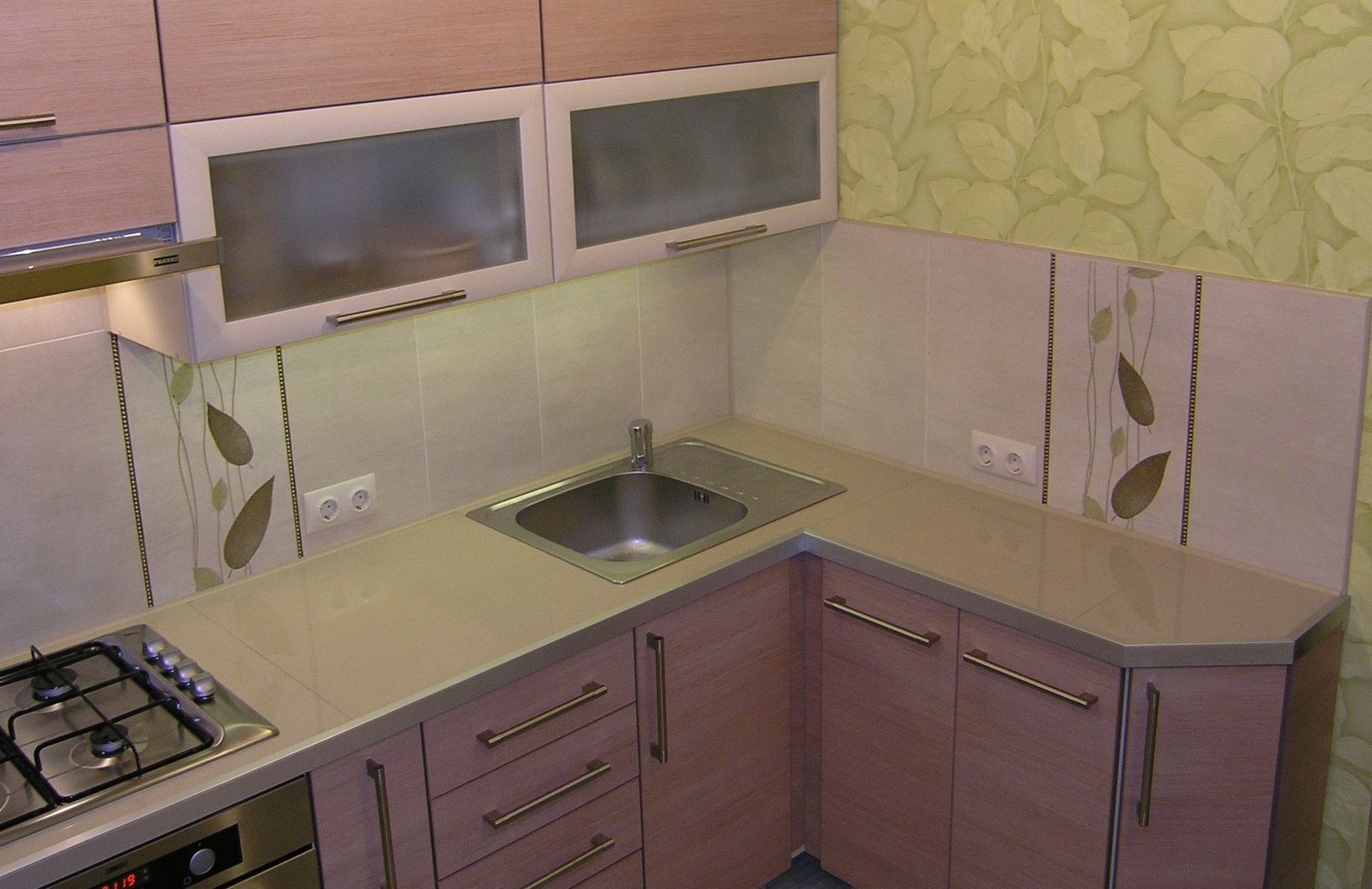
It is necessary to divide the surface of the countertop into a workspace area, a raw material area and a prepared product area.Calculate the optimal size for each of them. The length of the table top must be at least the sum of the lengths of all zones.

The distance from the surface of the table top to the top of the hostess's head should not exceed 70 cm. The lower “comfort distance” bar depends on the height at which the movement of the woman's elbow does not touch the edge of the table top.

The competent organization of any household process will inevitably affect the life of the household for the better. A competent choice of important elements of a kitchen set is the key to improving the quality of life not only for the hostess, but for the whole family.
Video: how to choose a countertop














